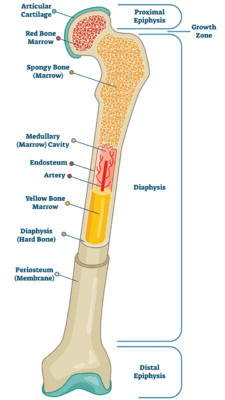Skeletal Stem Cells Found Living in the Growth Plates May One Day Make Us Taller
It’s always amazing to think that we are still discovering new stuff about the body well into the 21st century. One of the things we didn’t understand was how stem cells in your growth plates worked and even exactly where they lived. Now a new study has filled in this knowledge gap and discovered a new source of cells that may help repair musculoskeletal tissues.
What Is a Growth Plate?
To understand what a growth plate is, it’s important to understand the structure of our long bones. The two ends of the long bones have a section called the epiphysis, and the long middle portion is called the diaphysis (where the stem cell-rich bone marrow resides). When we are born, our long bones also come equipped with growth plates at each end between these two regions. The growth plates are cartilage-like structures where chondrocytes (or cartilage cells) rapidly divide near the epiphysis section and these new cells push down into the diaphysis section of the bone. Here they eventually calcify and are then hardened into new bone (a process called ossification). As we grow taller throughout childhood, the growth plates are ground zero for this process.

VectorMine/Shutterstock
Eventually, chondrocytes are depleted from the growth plate, the remaining cartilage ossifies, and we stop growing. There is an inactive remnant of the growth plate left behind called the epiphyseal line at the ends of the bones.
The Zones of the Growth Plate
Zooming in a bit closer, the growth plate consists of three zones: proliferative, hypertrophic, and resting. The proliferative zone is where those cartilage cells reproduce or divide. The hypertrophic zone is where the cells grow larger, drawing attention from nearby bone cells, which then begin the ossification process. The resting zone has been a bit of a mystery, but a new study suggests researchers may have found skeletal stem cells living there. Let’s review.
Have Researchers Identified the Elusive Skeletal Stem Cells?
In an effort to attempt to identify and locate skeletal stem cells outside of the bone marrow, the new study used fluorescent markers to identify and track the behaviors of certain cells over time in the growth plates of mice. Prior to this study, it was thought that cells in the resting zone were inactive (at rest or even dying). However, they discovered active cells in the resting zone of the growth plates that not only rapidly divide and produce bone and cartilage cells but also play a part in the production of blood cells—all properties similar to bone marrow stem cells.
They also identified a tightly controlled feedback loop to control these stem cells during long bone growth. Basically, they are controlled by messages from both sides of the growth plate–one positive causing more growth and one negative arresting growth. This last finding could one day hold the clues to conquering problems like dwarfism and short stature. Meaning, we could see an injection or even a medication pump inserted on one side of the growth plate to release chemical signals to trick the growth plate into producing more chondrocytes which will become bone.
Another reason this finding is important is that skeletal stem cells may be yet another therapy that can repair musculoskeletal tissues in the future. These stem cells can differentiate into many different cell types, such as bone cells (osteoblasts) chondrocytes (cartilage cells), and stroma cells, and can coordinate repair, maintain bone, and regulate bone growth. For example, imagine a future world where osteoporosis and fractured bones can be effectively treated with an injection of skeletal stem cells instead of drugs and surgery.
We now know that a part of the bone that we thought was inactive is actually rich with stem cells. In addition, this new discovery could both add another tool for regenerative medicine specialists to use to help heal orthopedic damage and new ways to solve short stature.

If you have questions or comments about this blog post, please email us at [email protected]
NOTE: This blog post provides general information to help the reader better understand regenerative medicine, musculoskeletal health, and related subjects. All content provided in this blog, website, or any linked materials, including text, graphics, images, patient profiles, outcomes, and information, are not intended and should not be considered or used as a substitute for medical advice, diagnosis, or treatment. Please always consult with a professional and certified healthcare provider to discuss if a treatment is right for you.